
` ` 63rd Issue EXPLORATION AND ADVANCEMENT European Students of Industrial Engineering and Management Issue 63 2022/11 | ISSN 0874-5242 | Price €0.- | www.estiem.org LEAN SIX SIGMA BRINGING AFRICA AND EUROPE TOGETHER PAGE 18 LET US BUILD A HOUSE OF WISDOM IN MEMORY OF JIM PLATTS PAGE 10
What is CENTRAL ESTIEM?

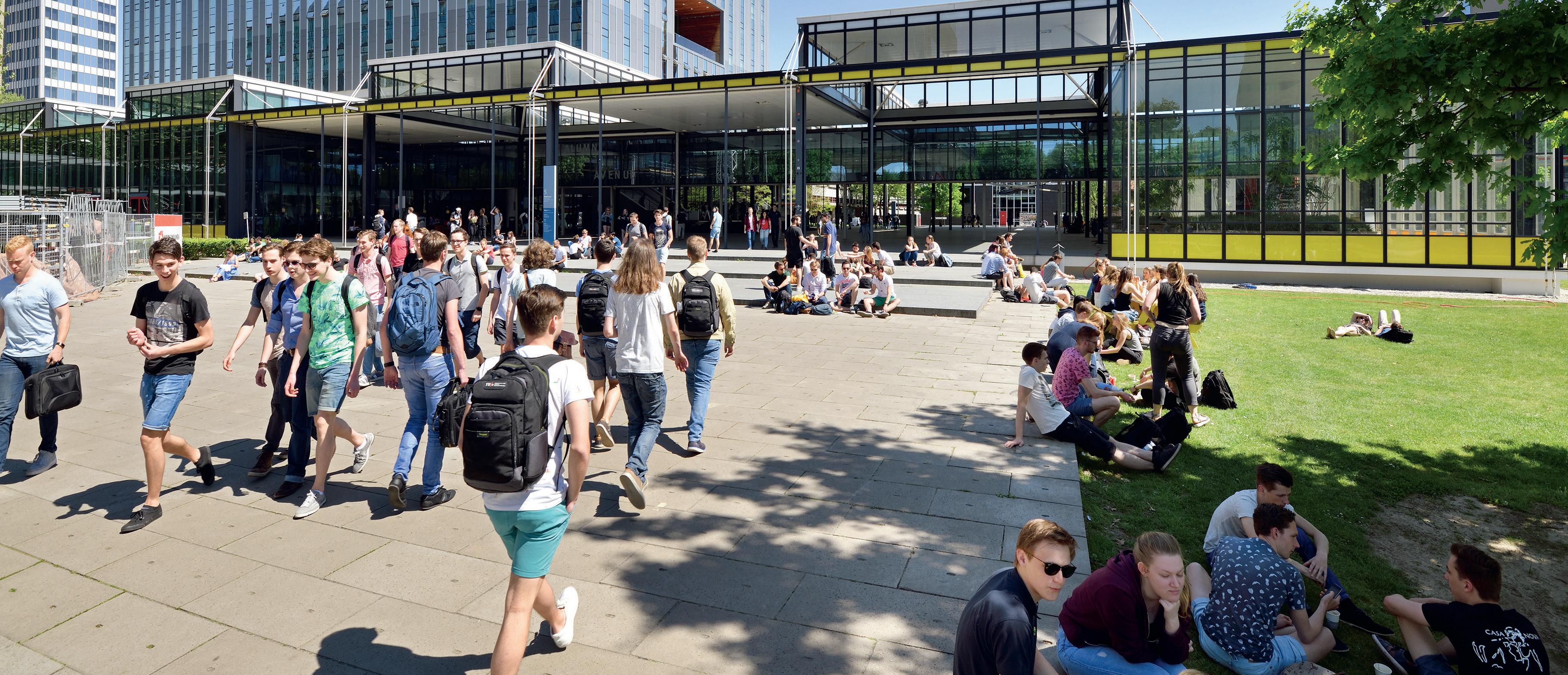


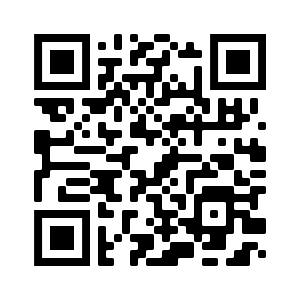

Central ESTIEM can be seen as the working place in ESTIEM. It aims to provide a framework where people can work to gether and develop their ideas with like-minded ESTIEMers. The Central ESTIEM structure consist of the board and se veral entities that support the board and the network and others that focus on the value creation by coordinating the organization of services. More information on Central ES TIEM can be found below.
Why join CENTRAL ESTIEM?
There are a many reasons why you should join Central ESTIEM. First of all, you will be working in an international team. In this team you can create your own impact by deve loping ideas or starting initiatives. Furthermore, it is a great opportunity to develop yourself by learning new things and improve a variety of skills. Last but not least, it is amazing to be part of an European Community. In this community you will make new friends, collaborate with people from diffe rent cultures and have a lot of fun!
2 ESTIEM Magazine | 63rd issue - Exploration and Advancement Pursue your Master’s program in the Netherlands?
the
in Industrial Engineering at Eindhoven University of Technology? tue.nl/masterprograms/oml • tue.nl/masterprograms/im • tue.nl/masterprograms/mse IE MSC wervingsad 210x135 mm.indd 1 18-06-19 09:33
What about
masters
Get Active! Page +180 Central ESTIEMers 29 Central Entities +120 Get Active! Chats since 2018 Join the Active Mail List Check Get Active! Page


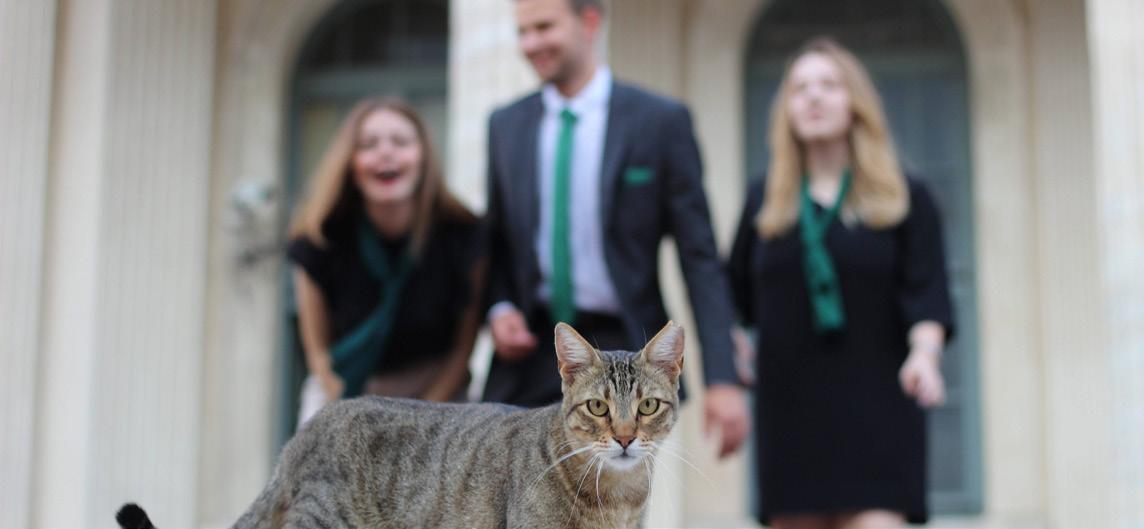

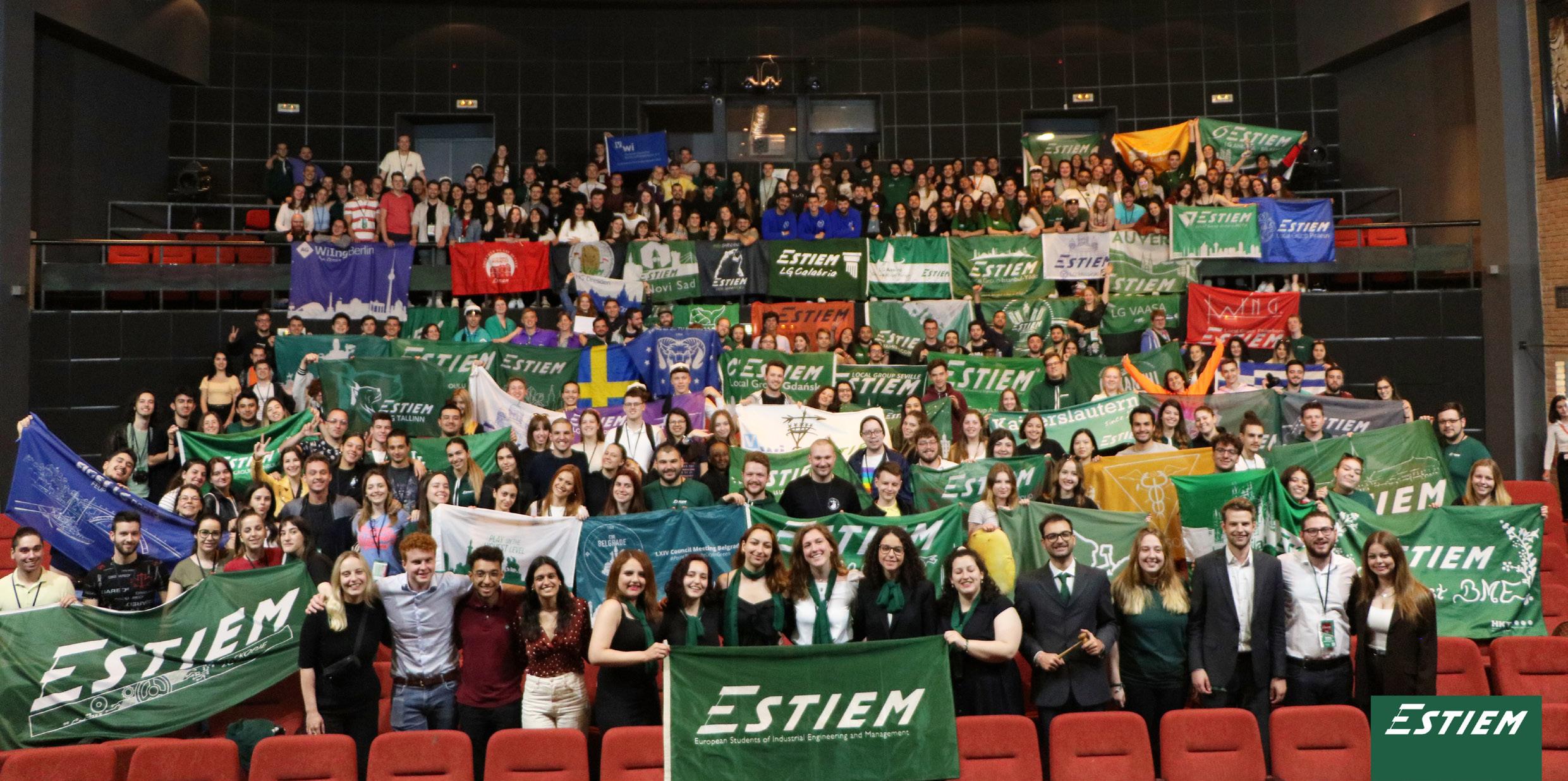
INTRODUCTION ESTIEM Magazine | 63rd issue - Exploration and Advancement 3
4 5 6 8 24 26
10 18 22 24 26 28 30 36 39 30 See you
Table of contents Project Leader’s Speech President’s Speech About ESTIEM Magazine Introduction to ESTIEM
Let us build the House of Wisdom - In Memory of Jim Platts Lean Six Sigma Bringing Africa & Europe Together Project Management with Scrum - Hume’s problem of induction How to Have Arguments and not Fights Meet the Alumni Board ESTIEM Trading Card Game Board Interviews - 32nd board interviews their successors ESTIEM Podcast - An Overview of the ESTIEM Podcast’s establishment over 2021 and 2022 How to Write for ESTIEM Magazine
somewhere in Europe!
Team
Tanja Gagić
Sara Simović Mina Krstić Stanislav Kanin

With special thanks to Petra Maria Kantartzi Sena Horoz Vivian Quoika Trajko Krstić
Contact leader.magazine@estiem. org
ESTIEM Permanent Office Atlas 2.328 P.O.Box 513 5600 MB Eindhoven, The Netherlands Fax: 0031-(0)40 2473871 info@estiem.org www.estiem.org
Disclaimer
The contents may not always reflect the opinion of the publisher. Any reproduction or copy is permitted only with the permission of the editors.
Our Partners ABB Continental Elium UNIT4 Tableau BEST EESTEC VWI ZEB Celonis
Eindhoven University of Technology Chalmers University of Technology
Lappeenranta University of Technology
European Society for Engineering Education (SEFI)

European Professors of Industrial Engineering and Management (EPIEM)
European Academy for Industrial Management (AIM)
ie3 project - Industrial Engineering and Management of European Higher Education
PROJECT LEADER’S SPEECH
Dear readers, I am writing this speech for the (I promise) last time in my life. For those that might not know it, this has been my third mandate (not consecutive, which is funny in itself) and this time it’s the final one. When you just join ESTIEM, you hear a lot about how “ESTIEM gives you back everything you give it” and while it could not be more true, I am at a point where I feel like I’m taking more than I can give anymore, so I am finally taking a healthy decision of letting it go.
In a weird, “this must be fate” kind of way, this issue’s focus topic is “Exploration and advancement” and the whole journey itself proved to me that we as people have so many paths to take, and it’s a matter of setting priorities that allows us to see full potential of each of them. We learn, we grow, we compete with ourselves, and in the end we get that satisfying feeling of looking back and recognising: hell yeah, I’ve made it this far. I hope you will get the same feeling while you read it. I am proud of the content in this issue, the team and the authors we’ve worked with were as awesome as you can imagine, and I still stand behind everything I’ve talked about the magazine in the past four years. I can’t wait to see what’s more to come.
Thank you to each and every one of you that were here with and for me through these crazy 5 years of my journey in the Magazine, thank you to all the predecessors that allowed me to have an amazing foundation to bulid upon, thank you to my sucessors that I know will (and already have) make me proud. All my friends, my boardies (lord knows I’ve seen too many), leaders, team members, readers, authors, alumni, sceptics, “haters” who I know loved me as much as I loved them, travel buddies,
See you somewhere in Europe.
In high ESTIEM, Tanja Gagić ESTIEM Magazine Project Leader
4 ESTIEM Magazine | 63rd issue - Exploration and Advancement
INTRODUCTION
random idea providers, bird lovers, soon-to-be authors, thank you, all of you. I hope you enjoy this entity’s work for years to come.
PRESIDENT’S SPEECH
Dear reader,
The topic of this edition of the ESTIEM Magazine focuses on one of the most significant features of humanity: exploration and advancement. Exploration means seeking and experimenting with new experiences or ideas. It is the foundation for advancement. It has allowed us to go beyond our boundaries and explore new territories, which has led to the development of new technologies, innovations, and opportunities.
The story of ESTIEM is the perfect example: When some of the founders were asked what defines ESTIEM, they replied that for them it is nothing else but “bringing together students from all over Europe that have a cultural curiosity and determination to achieve a common goal”. The founding idea arose from a “simple desire to travel and see Europe’’. And this desire to explore has also been the engine that has allowed this idea to grow into the network we know today: In the last 32 years, thousands of curious and determined ESTIEMers explored what is possible and turned those possibilities into advancements.
And what is next? How will the explorers of tomorrow shape ESTIEM? Only the future can tell, but I am convinced that when I google “ESTIEM” in 30 years, it will leave me smiling. This certainty comes from my belief that our timeless values ensure a bright future: diversity and participation support the exploration of ideas and opportunities. The strive for development and high-aimed ambition convert this exploration into advancement - not only for ESTIEM but also for you.
So live our values, go out, and explore what is possible.
Only those who explore can advance!
In high ESTIEM, Kai Heine

President of 33rd Board of ESTIEM

INTRODUCTION ESTIEM Magazine | 63rd issue - Exploration and Advancement 5
ABOUT ESTIEM MAGAZINE
Article Acquisiton
Task group in charge of contacting possible authors and collecting articles for the upcoming issue. They talk to authors, help them come up with the topic they want to write about, and prepare the articles for further processing by our team. The common misconception is that Magazine Team members write the articles - we don’t! We just collect them, but we can of course write if we want.
Proofreading
Task group in charge of proofreading and editing the articles. They make sure that everything is grammatically correct, that texts are easy to understand and in line with ESTIEM’s guidelines.
Design
Task group in charge of visuals of the Magazine. They design articles, and take care of posts on social media and blog. They make sure the Magazine is in line with ESTIEM’s visual identity.
Blog
Task group in charge of online publications of the magazine, primarily blog on Medium. They publish chosen articles from the printed edition and tailor it to fit the online environment.
leader.magazine@estiem.org
6 ESTIEM Magazine | 63rd issue - Exploration and Advancement INTRODUCTION
Look out for open calls or contact
to join us! All magazine issues Magazine Blog

INTRODUCTION ESTIEM Magazine | 63rd issue - Exploration and Advancement 7
ENJOY YOUR READING!
ALL OVER EUROPE...
Back in 1990, students from five different countries founded an organisation, which they named ESTIEM: European Students of Industrial Engineering and Management.
After 30 years, it has grown into an organisation bringing together over 60,000 students from 77 universities in 26 European countries, and it is still growing. All these universities offer courses in IEM. Based on this structure, ESTIEM forms links between students, academia and companies in order to create an Europe-wide, multi-level IEM network. ESTIEM has continuously increased the number of its activities, thus being able to offer a great variety of events to IEM students and an opportunity to experience different cultures, take part in international projects and become friends with other ESTIEMers from all over Europe.
Naturally, the backbone of ESTIEM is the European IEM student. The students involved in ESTIEM incorporate both the skills required for modern business and an open-minded approach towards other people and cultural issues.
The decision-making body of ESTIEM is the Council, which meets twice a year, in autumn and in spring. Each university, represented by its so-called “Local Group”, sends two student representatives. The six members of the Board of ESTIEM are elected during the spring Council Meeting. The Board is responsible for the management, coordination and administration of the association.
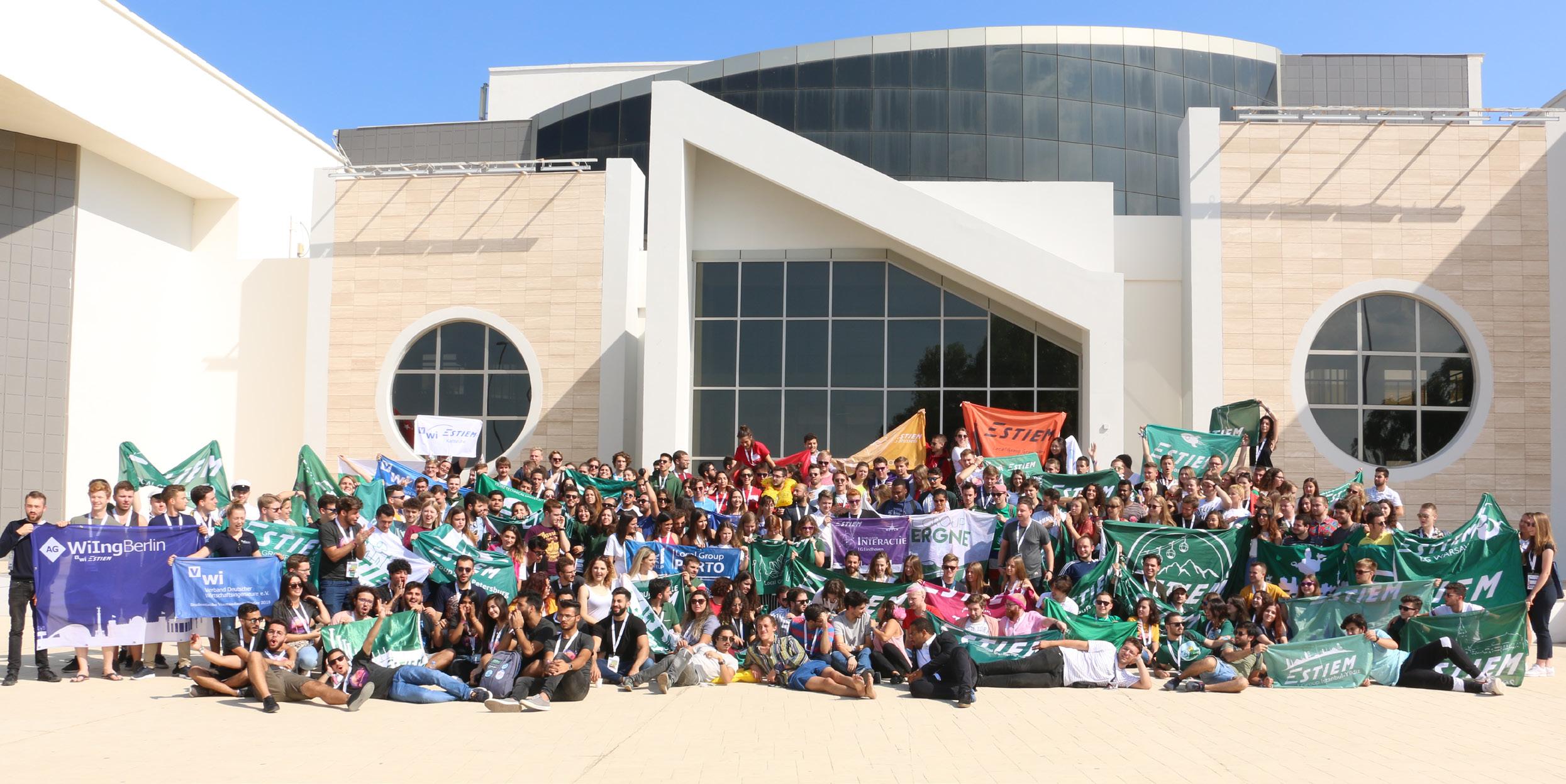
Besides taking leadership positions in the Board and as Project or Committee Leaders, ESTIEM members can also take up responsibilities by working in one of the Projects, Committees or Initiatives. With lots of teams and tasks to choose from, there is a place for everyone.
For more detailed information about our organisation and its activities, please visit our website at www.estiem.org.
77 180+ 3,000 8,000
Local Groups in 26 countries make ESTIEM a large network.
events are organised by Local Groups every year.
travels are made yearly by 2,000 students.
members and a reach of 60,000 towards IEM students in Europe.
8 ESTIEM Magazine | 63rd issue - Exploration and Advancement
INTRODUCTION
OUR MISSION
Connect and support the growth and sustainability of European associations of IEM students, to foster relations and to develop their IEM students, personally and professionall


OUR VISION
Be the connector of IEM Students with an IEM Europe
An IEM Europe is the ecosystem of companies, universities, organisations and other entities interested in the field of IEM. We are striving for each IEM Student to have a connection not only with other students all over Europe of the same field but also to other companies and universities, to ensure each student as a voice as well as the opportunity to make a difference, and to allow each outstanding innovative idea to become reality.
OUR FOUR CORE VALUES
Embracing diversity
We see multiculturalism as a strength of ESTIEM. We benefit from our cultural diversity by being able to approach chances and challenges with different insights. Respect is not just something we strive for, but part of the very basis of our network.

Striving for development
We grow together by trying hard and learning from mistakes, we are eager to go through a learning process and see accessibility and freedom as highest goals. ESTIEMers gain practical experience and important soft-skills needed in today’s world.
Encouraging participation

ESTIEM being a democratic organisation with a flat hierarchy encourages the participation of all its members. We inspire each other to partake in ESTIEM’s activities and develop new ideas.


Aiming high
We are not afraid of stepping out of our comfort zone. ESTIEM’s members are proactive students that always give 100%. We encourage an entrepreneurial spirit among students and other stakeholders by gathering and exchanging experiences and best practices.
INTRODUCTION ESTIEM Magazine | 63rd issue - Exploration and Advancement 9
David Christian Berg
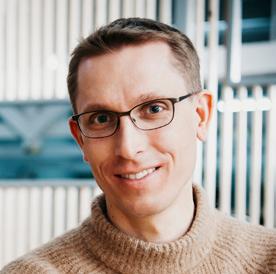
LET US BUILD THE HOUSE OF WISDOM

In memory of Jim Platts
“Sometimes you just have to get started.” Jim told the participants of Summer Academy 2012 when packing the van to ride to the venue. But it couldn’t be more true for the task of writing about Jim. There are so many facets one could start with that it’s hard to choose and get going.
to the improvement of wind turbines and their manufacturing processes. And as much as he was fascinated by the properties of high-performance composite materials used in wind turbine blades, he was in search of making them more sustainable by trying to incorporate renewable resources.
Marija Berg (née Turanjanin)

So let’s start by meeting Jim, the engineer and pioneer: His career in industry and academia revolved around bettering human impact on our planet and in our societies. Sustainability was important to Jim, long before it became fashionable and amongst many other contributions, he helped bring forward wind energy: first during his 23 years in industry by building up a lab that would later become the research and development centre of one of Europe’s largest wind turbine manufacturers; later at the University of Cambridge by dedicating much of his research
Working as a lecturer at the University of Cambridge was never mainly about good analyses or new inventions for Jim. “The core task is to enable people to grow” he once put it. And so he was focussing on the development of his students, convinced that he could have the biggest impact by educating leaders who would bring the change this world needs to see. That is also reflected in his devotion to teaching on ethical leadership, and his immense contributions to The Cambridge Manufacturing Leaders’ Programme.
10 ESTIEM Magazine | 63rd issue - Exploration and Advancement IN MEMORY
And so it was that the Local Group Cambridge asked Jim to be a mentor at a leadership seminar that ESTIEM was planning to organise during the summer of 2001. This invitation was the birth of Summer Academy as we know it and the start of a long, joint journey of Jim and ESTIEM. Summer Academy became “Jim’s” project and Jim’s Summer Academies were always life-changing experiences for the participants. He put an incredible passion into developing ESTIEMers to become true leaders rather than mere managers; to help them reflect and teach them empathic listening. He did so by the fruitful use of silence, a practice exercised by Quakers (who Jim was part of), an extremely powerful method for achieving the personal transformation Jim’s Summer Academies are known for.

He was always there as a mentor for everybody, no matter if they had attended his academy or not and no matter whether the questions were about personal life or academic struggles. He would always answer the shortest of an email with plenty of precious insight, leaving the recipient wonder as much about where his wisdom springs from as where he finds the time to give such
thorough answers. “Grandpa Jim” – he sometimes used to call himself that way – gave this wisdom unconditionally and with great warmth.
What started with Summer Academy became a deepening relationship between Jim and ESTIEM. While many of us ESTIEMers focus on the opportunities of personal growth and great fun that ESTIEM brings to us, Jim looked at ESTIEM from a bird’s-eye view, seeing it as a network that fosters mutual understanding, and a shared set of values – a project that would help secure peace within Europe. Sadly ESTIEM alone could of course not guarantee this peace, yet still ESTIEMers stand with one another during these trying times, proving how valuable the network’s contribution is.
To further strengthen the network, Jim was involved right from the beginning in what quickly came to be known as the IEM Caring Foundation, kicked it off with a significant donation and became one of the first members of the Club of 100. And even when the Foundation didn’t take the turns that he would have liked it to, he appreciated how it brings people together who strive for a more caring society.
IN MEMORY ESTIEM Magazine | 63rd issue - Exploration and Advancement 11
Jim Platts
Caring was also a great driver for Jim to bring to life the EPIEM network. In bringing together mindful academics from the IEM field, his aim was to create and foster a network that promotes care for our planet and the European society. In EPIEM, he was also very vocal about how caring for students and helping them grow by themselves was the only way profound education could take place.
With Jim’s death a seemingly endless source of wisdom has vanished. Jim himself had hoped to
build a “House of Wisdom” before he would leave; a place where his insight would be available to everyone who looked for it – easily accessible online. This project never caught any traction and the idea was unknown to most of us. While Jim can no longer directly contribute to such House of Wisdom, the wisdom he shared with so many of us, still is carried within us and can be passed on. There are also plenty of papers and presentations and even a book that are waiting to be shared. So let us bring together the bits and pieces and build the House of Wisdom!
The authors would like to thank all who shared their inspiring memories. Special thanks goes to Krasimira Natova for providing us with many emails and publications from Jim Platts.
Andreea Sabo
“Whether at work or simply reflecting on day to day life, Jim’s words are always there: “If you want to lead, learn first how to follow”, “Eliminating a person’s job is not eliminating what connects us to the person and being fired does not mean you are unworthy” – how true, so often I had to do this and Jim was always in my thoughts and supported me.
I also remember CM Karlsruhe, where he spoke about how we, ESTIEMers and Alumni “take away the causes of war” through our funny “fostering relations” … That’s what we really do, we take away the causes of war. We will continue doing this, Jim. Thank you for everything you have shown us, thank you for being our most-valued educator. “
Annett Juras
“Jim educated us about personal development and helped us with our own development process. He was an extraordinary personality who touched me and many others through his presence and his deep love for people and life very intensely.
I still carry the light within me. Thank you Jim!”
“Jim was a truly inspirational person who’s influence changed how many individualsincluding myself - see the purpose of their lives. He guided us through the journey of reflection and finding purpose. The memory of him will remain with me forever…”
12 ESTIEM Magazine | 63rd issue - Exploration and Advancement
IN MEMORY
Csaba Hartmann
Jim has had a transformational impact on me and my fellow attendants of the Summer Academy. He helped us to reflect on our presence and our mind. Most profoundly, he led us to self-discover the satisfaction and the responsibility we have as engineers and leaders to do good for our world and to make it a better place for more people and future generations. Jim might be physically not with us anymore, his teachings live on through us and I would hope we can carry his legacy forward to many future generations – the world depends on it.
SAC 2011 in Siegen, Germany with Jim Platts are memories that I’m carefully cherishing in my soul. Sometimes I try to explain to others how special he was, but to understand and feel that magic you must experience it by yourself.
For his generous sharing of the Light, for his support and meaningful conversations during and even after the SAC, I will be forever grateful. I wish all ESTIEMers will keep carrying the Light for our world.
Beautiful man, beautiful soul and beautiful life!
Jim had changed my life forever and tremendously. Before the seminar with him in 2007, I tried to be a good German engineer, after that a good human being. My perspective of the world was widened through his teachings on listening instead of reacting and I will always be thankful for that.

IN MEMORY ESTIEM Magazine | 63rd issue - Exploration and Advancement 13
Edwin van Rest
Elena Shepeleva
Elias Faethe
I did not only get to know Jim through SAC, where my understanding of myself was shattered through his deep reflective approach and my eyes opened towards a better me. His patience, deep thinking, sincerity, visionary sense... and still pertaining incredible sense of humour... were humbling in so many ways. The SAC community... and ESTIEM... has lost one of its shining lights.
Mirjam Keller (née Kirn)
During the last couple of months, one aspect of Summer Academy 2008 in Novi Sad has been on my mind more than ever: The concept of planting seeds amongst us as European Industrial Engineering and Management students, that would grow and multiply mutual understanding, a shared set of values with the ultimate aim to – the words of Jim still echo in my mind – prevent something that should never happen again: a situation of war in Europe.
Marija Berg (née Turanjanin)
Jim always reminded us to walk though the world with an open heart and an open mind. He taught us to give people second and third chances. Even without having attended his Summer Academy, I had exchanges with Jim I will always be grateful for. I keep carrying within me all the invaluable teachings and insights he shared.
João Barata
Jim dedicated his life to the betterment of humankind. We, ESTIEMers, were some of the fortunate people who were passed some of his metaphysical concepts, so that we could be members of our European societies who work in developing Europe in peace, through tolerance, empathy and understanding.
Marlies van Laarhoven
In the summer of 2013, Jim Platts encouraged me to get engaged with ESTIEM again. I treasure our exchange of deep thoughts and am grateful for our joint effort to foster caring among IEM students, alumni and professors. Our dream was to care for each other as a family and together care for the future of Europe. Thank you, Jim, for being you!
14 ESTIEM Magazine | 63rd issue - Exploration and Advancement IN MEMORY
Sebastian Geese
Jim gave guidance of deep wisdom to last me for a lifetime. Even today I can feel his teachings coming out of my memory of him, because he taught me how to access the internal guidance, which is always available when we turn to it.
Haluk Akin
Very few people had his level of influence on my communication and even leadership skills. Sometimes my colleagues ask me how I manage to listen so well. It is not a gift, Jim trained SAC participants for this, besides many other skills, and being a good leader starts with good listening. He also wanted us to find the meaning in the work we do, so he made sure all of us find that meaning for our works for life. He was an extraordinary Cambridge man. I just cannot thank him enough.
Marin Jovanović
Jim taught us that the best leaders are like gardeners who nurture plants to grow into beautiful flowers. Jim was an extraordinary person, almost mystical, wise, kind and disarmingly honest. His legacy to create a new generation of sustainability leaders will be remembered with ESTIEM, Summer Academies and his students.
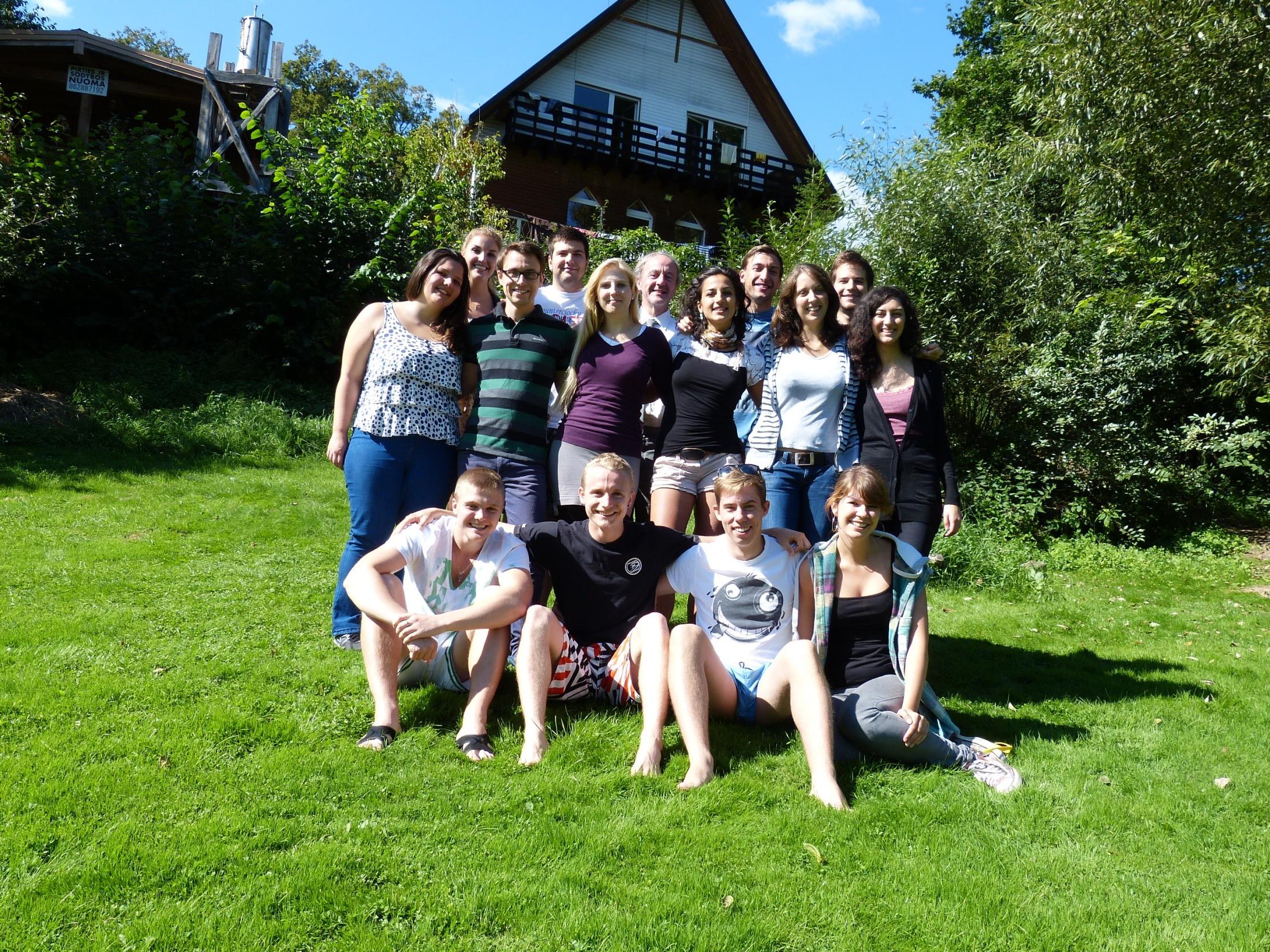
ESTIEM Magazine | 63rd issue - Exploration and Advancement 15
Krasimira Natova
Natalie Gyárfás
Many ESTIEMers remember Jim as an engineering professor, but he also offered his support as a grandfather figure to all of us. In the 10 years Jim and I have known each other, there wasn’t any occasion when he wouldn’t be there for me - may it be about the development of an ESTIEM initiative, a reflection I was keen to share with him, or a personal life situation where I desperately needed his guidance. Especially since I live in the UK, our relationship slowly transformed from Jim being my teacher to becoming my honorary ‘English grandad’. I will miss him greatly. I am grateful for the time we shared together, and for his endless care, love, and the teachings that live within me.
Gregor Herr
Jim is definitely one of the persons who had the biggest impact on my development as a human being – right after my parents. I started to embrace my skills and abilities during the two weeks of Summer Academy with Jim and learnt how to leverage them best to serve mankind!
Thank you Jim – it was a true honour to participate in your last SAC Summer 2013 in lovely Lithuania. Now it is up to us as Summer Academy Alumni to serve and inspire the next generations of ESTIEMers to embrace the change they would like to see in the world!
Quotes from Jim Platts






A true master craftsman has [...] a deep understanding of humanity itself so that they are able to see what needs to be crafted, and at the same time they deeply understand and can guide students through the process of struggle, learning and growth that yields maturity.
It is the responsibilities that you pick up which in fact shape you. It is being a husband, father, farmer, goat keeper, teacher that defines me, all of them responsibilities for caring for people and things and not about wanting anything. Being of service to others is what life is about.
Listening is the skill. Not talking, Not talking nicely.
16 ESTIEM Magazine | 63rd issue - Exploration and Advancement IN MEMORY
Sometimes you just have to get started. We will figure it out.
We should live in the light of that spirit which removes the causes of war. This is much more than not fighting.
Teaching happens from within, it cannot take place without the student.
Leadership is growing flowers in people’s hearts.
Jim Platts Scholarship








To honour Jim we will bring to life an idea Jim brought to ESTIEM and the IEM Caring Foundation some years ago: an essay competition. Based on this competition, each year one student will be awarded a scholarship to attend the Summer Academy. Further details regarding the process will follow.

IN MEMORY ESTIEM Magazine | 63rd issue - Exploration and Advancement 17
Raúl Sotillo Local Group Seville
LEAN SIX SIGMA BRINGING AFRICA & EUROPE TOGETHER
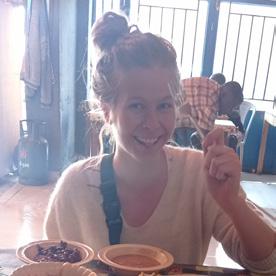

Many of us have heard about ESTIEM’s driving and globally highly valued Lean Six Sigma (LSS) courses that culminate into a Green belt certificate and a springboard for continuing to Black Belt level. Since 2018, over 1040 ESTIEMers have participated in the Lean Six Sigma courses across Europe and over 135 participants have become LSS trainers. In spring 2022, we got an invitation to host the course for the first time outside Europe, in Kigali (Rwanda, Africa) and of course took the opportunity. To know more about ESTIEM LSS courses, you can find more information at:

The course
The 7-days intensive course brought together a diverse team of 25 young talents from four different study programs including engineering, agronomics, finance and computer science. The course was a success and all 25 students were certified. For participants, the certificate is a great asset in career development and it enables them to become trainers themselves.
The university offered us a great space, and made a big effort to make everyone feel comfortable. Although some of them struggled with some technical content, the students the content was completely understood (sometimes we had to use examples with things that were more familiar for them) and whenever one was understanding the point they were helping us to explain to the others.
FOCUS TOPIC 18 ESTIEM Magazine | 63rd issue - Exploration and Advancement
Maija Luukka Local Group Lappeenranta
ESTIEM Lean Six Sigma
During this week, we had the opportunity to travel to more rural areas in Rwanda with a motorbike and get to know the reality of this part of the world. We also could meet incredible people like Benjamin (that invited us to his Start-up Incubator) and Mark Bagabe, a Lean Six Sigma professional who returned to Rwanda after the genocide in 1994 to rebuild the society. Nowadays, Max is providing LSS based consultancy for governments and companies across the world. We talked for hours about the important role of quality development in places like this.

“We learned a lot and got new skills in data analysis, project management, and even presentation skills. It will help me in my career and research. I enjoyed the course and it was really really fun!”
“I want to thank you for the great Lean Six Sigma course. I need these skills for my career.”
“We learned ways for identifying problems and improving processes. As a project manager, I will right away eliminate and reduce waste and reduce the process variation in my work processes.”
“I liked this training because it was so practical from the beginning till the end. I learned especially well in the team exercises.”












“I learned how to be sharp and solve business problems.”
“I cannot wait for hosting Lean Six Sigma course myself”
FOCUS TOPIC ESTIEM Magazine | 63rd issue - Exploration and Advancement 19
The vision of this LSS initiative is to create a network of courses, extend the project’s boundaries throughout Africa, and create an international network of trainers like the one currently in place at ESTIEM throughout Europe, working together to achieve our goal: to create a sustainable LSS ecosystem both locally and internationally.
Now that its economy is growing so fast and its youth is so empowered, this knowledge comes very in handy for anyone starting their career or wanting to take their business into the next level. As we know, the quality knowledge & understanding of data is becoming ever more vital in international markets, and LSS offers valuable, yet extremely concrete, tools for harnessing data and turning it into process changes and improvements.
We believe that success and growth come from within and that developing societies should be provided with the necessary tools to grow on their own, rather than being maintained with donations. Knowledge and data are more valuable than money, as they prevail over time.

Next steps

As said, the next step in this cross-continental collaboration is to continue hosting Lean Six Sigma courses at the University of Kigali in collaboration with the local students. There is a team actively working on the next course that takes place the H1/2023, and we want you o join us to make this happen.
This next step is to organise the LSS course with the local trainers and invite even more collaborators from the local companies. At the same time, the continuation of the course in Kigali offers ESTIEMers a unique opportunity to build collaboration with African IEM students, companies, universities and other organisations. By collaborating across continents, we can learn from each other and grow together.

FOCUS TOPIC 20 ESTIEM Magazine | 63rd issue - Exploration and Advancement
We are looking for a motivated team to help us get contacts with universities, companies and potential partners, that will ensure the continuance and sustainability of the project.


If you’re curious to learn more about the Lean Six Sigma courses in Africa, would like to join the team as a changemaker, a contributor and/or LSS trainer, or have some other ideas to be shared, please contact Raúl: raul.sotillo@estiem.org You can also find more information in the long article that we also published in Elium:
Elium post

Infinite thanks to Jukkas, Martijn, Yassine, and the whole team that made it possible.
We encourage everyone to join this project, the future of Lean Six Sigma looks exciting. See you somewhere in Africa or Europe!
Cheers!

FOCUS TOPIC ESTIEM Magazine | 63rd issue - Exploration and Advancement 21
Vivian Quoika Local Group Hamburg
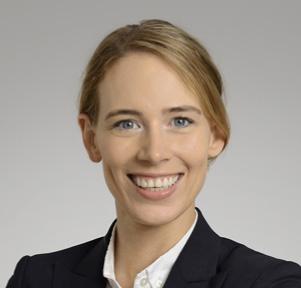
PROJECT MANAGEMENT WITH SCRUM
Hume’s problem of induction
In the 17ths century the Scottish philosopher and economist David Hume was thinking about how to make scientific discoveries when you derive your knowledge from existing conclusions. Mental models and deductive relations of logical consequences according to Hume can never make a truly new discovery. A lot of knowledge can be found within a cause-and-effect relationship. But regardless of how many white swan cases we may observe, this does not justify the conclusion that all swans are white, there are some discoveries which can only be found through new exploration, for example “a black swan” event.
The best way to include exploration in project management is through scrum project management.
The scrum project management framework was initially developed by Ken Schwaber and Jeff Sutherland. But to take a look at the scrum framework, we need to contrast it to the classic waterfall project management waterfall model which came up in the 1970s. The waterfall model breaks down the project activities in linear sequential phases. Each phase is specialized for one type of task and it depends on the deliverables of the previous phases. This waterfall approach is still standard for many projects and has many benefits but even Winston Royce, who described the waterfall model for the first time, found a few shortcomings in it. For example, there tends to be different specialists involved in every project phase. In waterfall project management there is a tendency of postponing some problems until the end of the project. Also testing won’t be done until the very end of the project. There is also a big ‘upfront’ Analysis and Design phase which fixes detail in requirements.
So what is Scrum? Exploration and advancement in knowledge or advancement in product development can only be done with exploration. Exploration means broadening one’s horizon and learning something new as a project team.
Scrum works with time-boxing, division in work packages and continuous development of a solution. Every 2-4 weeks, there are feedback loops where the project team decides which work
packages are worked on until the end of the next feedback loop. In the time of the “Sprint” regular alignment meetings take place to find out if there are any hurdles or synergies with other tasks. At the end of the “Sprint” an enhanced product can be deployed and shown to the customer. The time-boxing iteration starts again and so working on a new set of work packages.
Since the project is organized in time-boxes the project is more flexible. It can adapt to a changing project environment more easily. If there are changes from the customer side this can be as well reprioritized in the next time-box. There is continuous development with features which have a high priority. It can adapt to a changing project environment very easily. Also changing priorities from the customer side is not a problem, since new work packages are planned and can be as well reprioritized in the next time-box. There is continuous development with features which have a high priority.
Philosopher Karl Hume’s problem of induction about expecting white swans when you have online seen white swans before. His induction problem questions our reasons for believing that the future will resemble the past and questions if it makes sense to make predictions based on previous observations. How can we find something new? The explorative scrum methodology gives a good framework of team management in a volatile environment. The scrum methodology is a means of organizing exploration and achievement.
FOCUS TOPIC 22 ESTIEM Magazine | 63rd issue - Exploration and Advancement
References

1. Sutherland, Jeffrey Victor; Schwaber, Ken (1995). Business object design and implementation: OOPSLA ‘95 workshop proceedings. The University of Michigan. p. 118. ISBN 978-3-54076096-2.
2. Royce, Winston (1970), “Managing the Development of Large Software Systems” (PDF), Proceedings of IEEE WESCON, 26 (August): 1–9

FOCUS TOPIC ESTIEM Magazine | 63rd issue - Exploration and Advancement 23
Fco Javier Jimenez Pareja Local Group Seville

HOW TO HAVE ARGUMENTS AND NOT FIGHTS




There is a difference between having a fight and having an argument with someone. The first step to understanding why you’re fighting badly is understanding that you shouldn’t be fighting at all. Yes, the first piece of advice I will give you is to avoid any sort of argument that will bring more bad than good. But, since sometimes you can’t escape it, here are some tips on what you can do to make discussions with opposing views be useful instead of passionate quarrels with no real outcome except emotional.
No side is perfect
One thing you should try avoiding is simply telling the other person “You are doing this wrong” instead of helping them see where your point of view comes from. This could damage their pride or make them defensive, and it will be impossible for both of you to obtain what you want no matter how right either of you are. We can try to be more subtle in our objective as you will find out in this text.
Some time ago, a friend told me:
He was absolutely right.
Admit your mistake
If you start fighting, you will only get the other party to do the same. On another hand, if you start by saying you understand your influence on the discussion and that you could be wrong, you will get much more than you can imagine. People will see you as a person who is ready to argue their opinion, but at the same time willing to hear the others! Start analysing what could be your own mistakes and faults before criticising others, because this way you will be emphasizing that you are aware you might not be right and you are both wrong to a certain extent, in a way that gives way to seeking a common solution and not fighting about who is right or who is not.
An old Chinese proverb from Lao-Tse relates how the seas and oceans receive the tribute of thousands of rivers, by staying under them. In the same way that happens with people, if you want to find the truth, you should not emphasize your opinion, you should stay below others, so they do not feel that pressure on them.
Encourage others to talk
Let the other person speak, ask and listen carefully to what they want to say and express, because no one knows more about a person’s problems and concerns than themselves. Listen respectfully and be sincerely interested in what that person has to say about it, because if you manage to understand the reason why they act and think as they do, you will have achieved the magic formula to discuss with that person and get further into understanding with them according to your wishes.
SCENE 24 ESTIEM Magazine | 63rd issue - Exploration and Advancement
“When arguing with a fool, make sure the opponent isn’t doing the exact same thing.”
- Abraham Lincoln
“If you want to collect honey, don’t kick the hive.”
Not only that, but you will have done it in a way in which the other person will feel good about themselves and how the situation has been resolved, since both of you have contributed to its resolution. This is basically called a win-win.


Make the other person feel important
There are hundreds of books and studies on this subject, and with a good reason. They explain that the human being has a series of basic desires and needs, such as health, food, dreams, money and many others; but at the top of that list there is a sense of self-importance. It is not a bad thing; it is not something of egocentric people and there is no need to regret it. It is strictly how our brain works and how the connections in it interact. If you are able to make the person see that you value them highly, they will probably try to show to you a good will to justify it. So, if you try to get someone to do something they don’t want to (for example, find your opinion to be true) - it is very simple. They most likely won’t do it. But if you explain why their contribution or belief would be valuable to your cause, why you believe in their abilities, that person will feel motivated to actually prove to you that your opinion is correct and try to put more effort into understanding you. There are not many things as important to a person as their perception of themselves and how it aligns with the perception of the world… Well, there is something.
Hello, my name is Javier, what is yours? Dale Carnegie said: “The name of a person is for him the sweetest and most important sound he can hear” and he was right, because remembering the name of the other person and mentioning it subtly leads the person to tend to be more susceptible and open to ideas, because you are in an environment of trust and your brain tends to relax and avoid tension. So whenever you meet someone, just try to remember his name as strong as you can.
Use the carrot and not the stick
Have you heard this expression before? Since we were all kids, we were taught that nobody likes to change their mind and nobody can be forced to agree with your point of view, but what is possible is to lead the other person to it. If we are soft and kind, and use the carrot instead of trying to achieve our goal by using force or threats against the other person, we can help them see our perspective and understanding why we think our opinion is correct. At the same time, they have a free way to convince us in their opinion, which makes them less defensive and more open to discussion!
“If you come at me with your clenched fists, I can promise you that mine will clench faster than yours; but if you come and tell me: ‘Let’s sit down and talk, let’s try to see where we disagree and try to find a common point’, I promise to do everything in my power to reach a good port together.“
- Woodrow Wilson

Understand everyone, including yourself
Perhaps you have thought that these tips that you have seen are some trick or that they simply will not work, and perhaps you are right; but according to my own personal experience, if you apply and implement them in your daily life, you will achieve results that you cannot expect. Approach any sort of clash in opinions with care for yourself and other person, consider the circumstances, environment and emotions. After all, it is all about trying to be a better, understanding person, all in the name of coming to a conclusion together, not against each other.
MEET THE ESTIEM ALUMNI BOARD

Every year ESTIEM Alumni elect a new board to lead more than 1500 members of the Alumni organization. This year the ESTIEM Alumni Board consists of 3 members who decided to come together to fully experience the ESTIEM Spirit again. Their names are Lassi Uosukainen, Alaz Ata Senol and Vivian Quoika. We want you to meet them!
In the ESTIEM Alumni the number of board members is not fixed unlike ESTIEM. The number of board members and their positions varies depending on how many applicants there are. This year there are only 3 members but they will work twice as hard to achieve their goals.
Lassi joined ESTIEM in 2013 and is from LG Tampere. He was in the 26th ESTIEM Board in 2016 and was really active in the ITC developing the new ESTIEM Portal. Currently he is based in Berlin where he works as a software developer. He likes to take unconventional routes to ESTIEM events often including trains and bicycle rides.
Alaz is from LG Ankara Bilkent and has been in ESTIEM since 2012. Currently he lives in Istanbul and works as an international marketing specialist for a ceramic sanitaryware company. He was also a member of the 26th Board of ESTIEM as the VP of Activities and ESTIEMers from those times can remember him from karaoke parties. He watches almost every sport imaginable and is a fan of Besiktas, a football club based in Istanbul.
Vivian has been in ESTIEM since 2013 and she was an active member of LG Hamburg. She is still in Hamburg where she is currently doing her PhD after being an IT consultant for some years. She likes to go to events of all kinds and works as a teacher for SAP in her university. Traveling and exploring different cultures within Europe is her passion.
CAREER 26 ESTIEM Magazine | 63rd issue - Exploration and Advancement
2022/2023!
As the new ESTIEM Alumni Board we are excited to see you again in real life now that the isolation is mostly over. We will try to organize events in different areas of Europe so as many of you as possible have the chance to attend. You can also join alumni activities if you are still a student and you can have the chance to learn something new from the alumni.
If you have any questions about ESTIEM Alumni or you want to become a member of the Alumni network you can reach us at board.alumni@ estiem.org. You can also apply to the alumni on the ESTIEM portal. We look forward to seeing you somewhere in Europe this year!

CAREER ESTIEM Magazine | 63rd issue - Exploration and Advancement 27
Join ESTIEM Alumni
Erik Viktor Pymay Jasinski Local Group Gothenburg
ESTIEM TRADING CARD GAME

How I stopped worrying and started to love ESTIEM as a playground
Constantly throughout our ESTIEM journey, we are met with vague, yet fun-sounding buzzwords. One of those that I have stumbled across quite a lot is “ESTIEM is a playground.” What does that mean? Through my recent experiences, I managed to discover just how much of a playground our network can actually be.
The Origins The Development
A year ago I got an idea. In a random chat with the ESTIEM board, on a completely unrelated topic I came up with an idea to create something like the Pokemon Trading Card Game, but for ESTIEMers. This idea would easily be extinguished, like all other daily ideas I have, but I shared it with some friends from the organization and they pushed me into pursuing the thought further. So I sat down and started writing some thoughts down, shared them with the network and immediately got a lot of reactions, suggestions and comments on how to develop the card game.
Fast forward some time and I made the public announcement during CM LXIII in Seville, where I acquired a budget from the Ad Fundum award and presented a first plan on how to make the ETCG project a reality to a crowd of 200 people. After that, I managed to gather a wonderful team of highly skilled and knowledgeable members. As the team grew during the next months it helped me growing the project. Since then, the card game resembled the process of a startup where we got to design a product, perform various trials of it throughout the network, develop supply chains, use some creative marketing and finally deliver the first edition in a Steve Job’esque style. Though the first edition had to be delayed in the end due to late shipments, I got a lot of practical insights on how to manage stakeholders and how to handle crises.
Having traveled this journey, I can pinpoint to you the exact moments where I would fail or at least be severely impaired in my work, if it did not happen in the environment of our organization. First of all, in the cradle of the idea when I had the concept in the back of my head ready to be turned to reality, in every other case a couple days would pass and I would naturally forget about the project. Instead I shared the idea with a couple of other ESTIEMers and got the support of peers that believed in me and pushed me to pursue the project.
Secondly, I do not think that I could reach people with expertise in the fields I needed this easily in any other organization, as I had no problem finding ESTIEMers eager to contribute with their knowledge on cards, games, design and logistics. Without these people and their knowledge, the project would take way longer and would meet significantly more dead ends.
When the idea of the cards was ready to be evaluated in real life, the ESTIEM network of people proved to be a huge resource while trying the concept out in a “real market”. ESTIEMers throughout the network were happy to try the new idea out and I could with minimal effort have new prototypes of the card game tested among various different groups of subjects with different cultural backgrounds, with different positions in the network and different interests, to understand who would be interested in the final product. A real life product would require extensive marketing teams and third parties to reach such a broad target group as I did.
Lastly, during the most important moment so far for the card game, the presentation and the distribution of the first official edition of cards, we hit a major setback, as the cards were not delivered
INSIDE ESTIEM 28 ESTIEM Magazine | 63rd issue - Exploration and Advancement
on time and we had nothing to show to our stakeholders. In a real industry, the consequences of such a failure would cause immense damage to the company, leading to loss of revenue, delays in the marketing of the product and, most importantly, loss of trust from stakeholders. I would surely end up fired from the job, if not sued. In ESTIEM on the other hand, the losses were only in the form of delays in the card game and a couple irritated ESTIEMers.Thanks to the mindset of a playground, the only relevant consequence of this failure was a valuable lesson learned that I can take with me to my future professional life.
The Conclusion
The stories of dreams turned reality do not stop at card games. Everything in our network started off as a ridiculous idea that someone had in their head that they didn’t let go of and kept pursuing. The Tournament in Management and Engineering Skills (TIMES) started off as a way for ESTIEM to raise funds. An ESTIEMer from Dresden had a vision to gather ESTIEMers in one place to really dive deep into that country’s kulture, economics and politics and poof - Europe 3D was born.
The Data Science Course came from a brilliant guy who saw the data driven world around us and wanted to find a way to teach the network about visual storytelling with data.
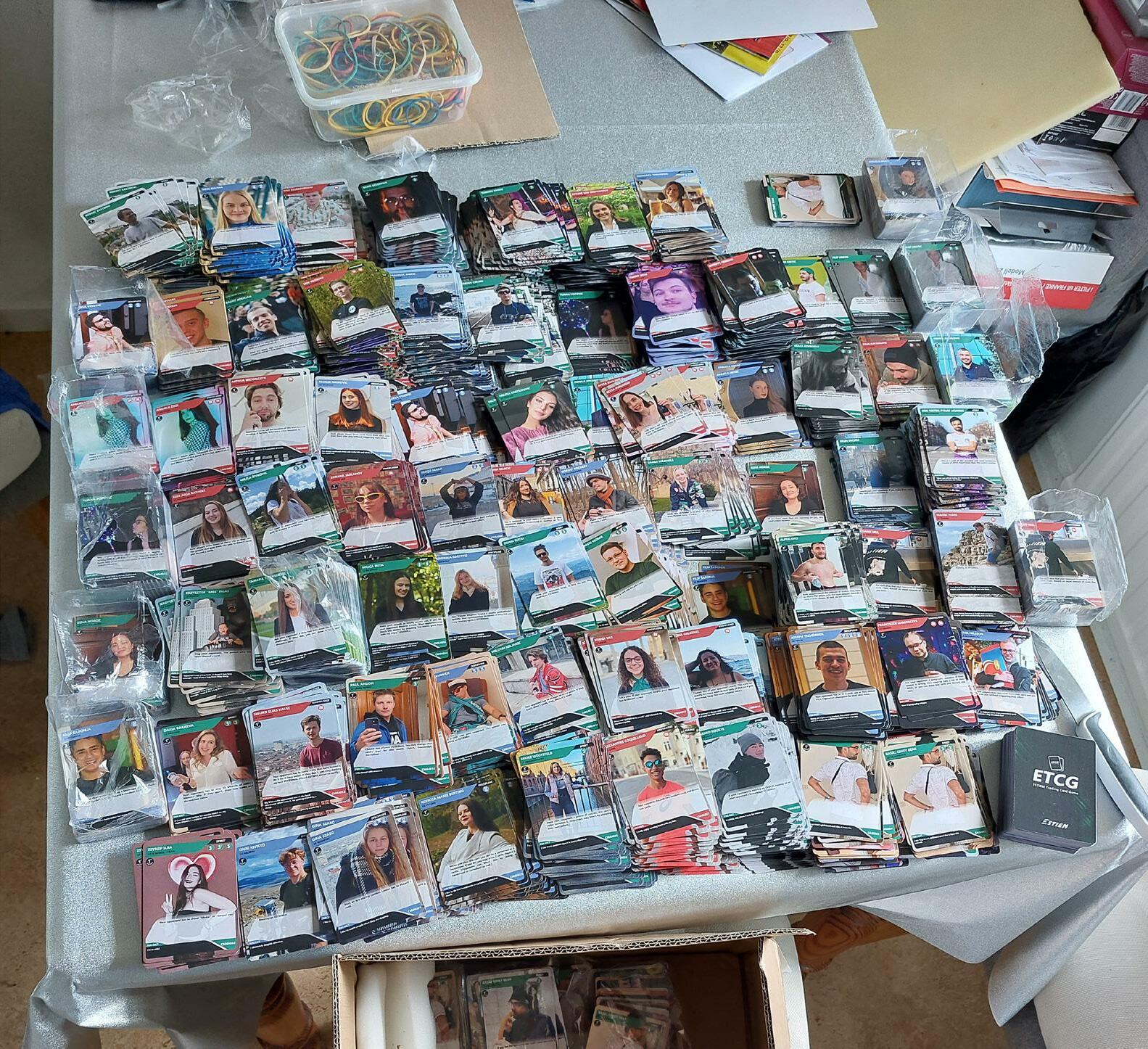
All of our projects are made possible by the support of the networks and we are presented with the unique opportunity that the playground mindset provides us. ESTIEM is built on the ideas created by ESTIEMers so this is my plead to you, dear reader. Let your creativity flow, take the opportunity at hand, who knows when you will have such an opportunity again? Go pursue that idea that is on your mind! Make a course that will teach ESTIEMers a hard skill. Find a way to resurrect ESTIEMs cashflow. Heck, I won’t mind if you even start another card game! The opportunities are really at your fingertips and anything is possible, if you only want to pursue it. The only thing you have to fear is… well not really anything, that was kinda my point with this whole text.
I will finish this article by stressing my main point once again. Our network gives us the opportunities to pursue all our ideas. Use this opportunity. I did. And I do not regret it.
INSIDE ESTIEM ESTIEM Magazine | 63rd issue - Exploration and Advancement 29
BOARD INTERVIEWS
32nd board members interview their successors. Vice President of Administration:


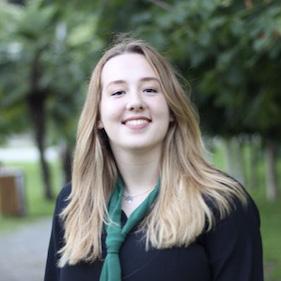
N: The board year is a challenging experience and you may find yourself overwhelmed at times. The best advice I can give you is to find the parts that you enjoy the most in the network and focus on them. So my question is: What are the aspects of ESTIEM that give you a sense of fulfilment?
E: For me, it’s all about the people. Helping others, knowing that I can make a difference in other people’s lives and acting with dedication as much as I can in every action I take, that is what is the most fulfilling to me. I believe this goes through working on things I enjoy, creating an impact in our network and leaving meaningful work for the next generation.
N: Imagine yourself on the last day of your mandate. How do you see yourself then? What are your biggest personal accomplishments?
E: When I look back to my board year, I would like to be able to say that I did the best and enjoyed my year with the people I worked with while growing as a person myself. I would like to look back at fruitful collaboration with the various personalities and I would like to see that everyone’s values and feelings have been protected. And most importantly, I would like to see myself being proud of the fact that I have been able to realize when things have gone wrong and to do my best to get the things on the right track.
N: Do you have any plans in finding the long lost Admin Webcam? If yes, what are those?
E: I do have plans, indeed! As far as I heard it’s somewhere in Portgual, searching for the Admin Webcam will be my first task when I arrive at CM Porto :)
INSIDE ESTIEM 30 ESTIEM Magazine | 63rd issue - Exploration and Advancement
Nikolina Gklezaki interviews Esin Rathert
Nikolina Gklezaki Local Group Xanthi
Esin Rathert Local Group Ankara-Bilkent
H: While being on the board, the work may be too much or not so motivating. What is the one thing that gives you great motivation?
S: All ESTIEMers, seeing that events are happening, talking to people, and also of course going to events!
H: What would you like to see at the end of the year as your biggest accomplishment related to your position?

S: When I started to think about applying for the board, I always knew I would like to apply for VP of Activities, but I never had one big thing I would like to change about the network so if at the end of the year I have managed to make event organization better; easier to understand and the knowledge accessible, I would be happy.
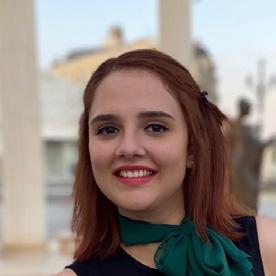

H: How would you ensure that LGs have needed knowledge and they are motivated to organize events?
S: I would ensure the knowledge by having close communication with Regional Coordinators and Service Leaders and by working on the upcoming wordpress page for ESTIEM to ensure the knowledge is accessible for everyone. I think the motivation to organize events needs to come from the Local Groups themselves. However this motivation could be increased by sharing experiences, encouraging them to first organize a smaller event, which requires maybe less effort, and spreading the ESTIEM Spirit.
H: Which ESTIEM Tradition is your favorite?
S: My favorite ESTIEM Tradition is definitely doing the HAKA.
INSIDE ESTIEM ESTIEM Magazine | 63rd issue - Exploration and Advancement 31
Vice President of Activities:
Helin Ergezer interviews Saara Maenpaa
Helin Ergezer Local Group Izmir-Economy
Saara Maenpaa Local Group Lappeenranta
J: What is one change in formal education that you think ESTIEM can contribute to?
F: ESTIEM can contribute to a shift in the mindset of students being only “customers” of degrees, to students being seen as partners or contributors when it comes to the development of formal education.
J: ESTIEM’s Vision is to be the connector of IEM Students with an IEM Europe. How would you like to see students improving these connections?
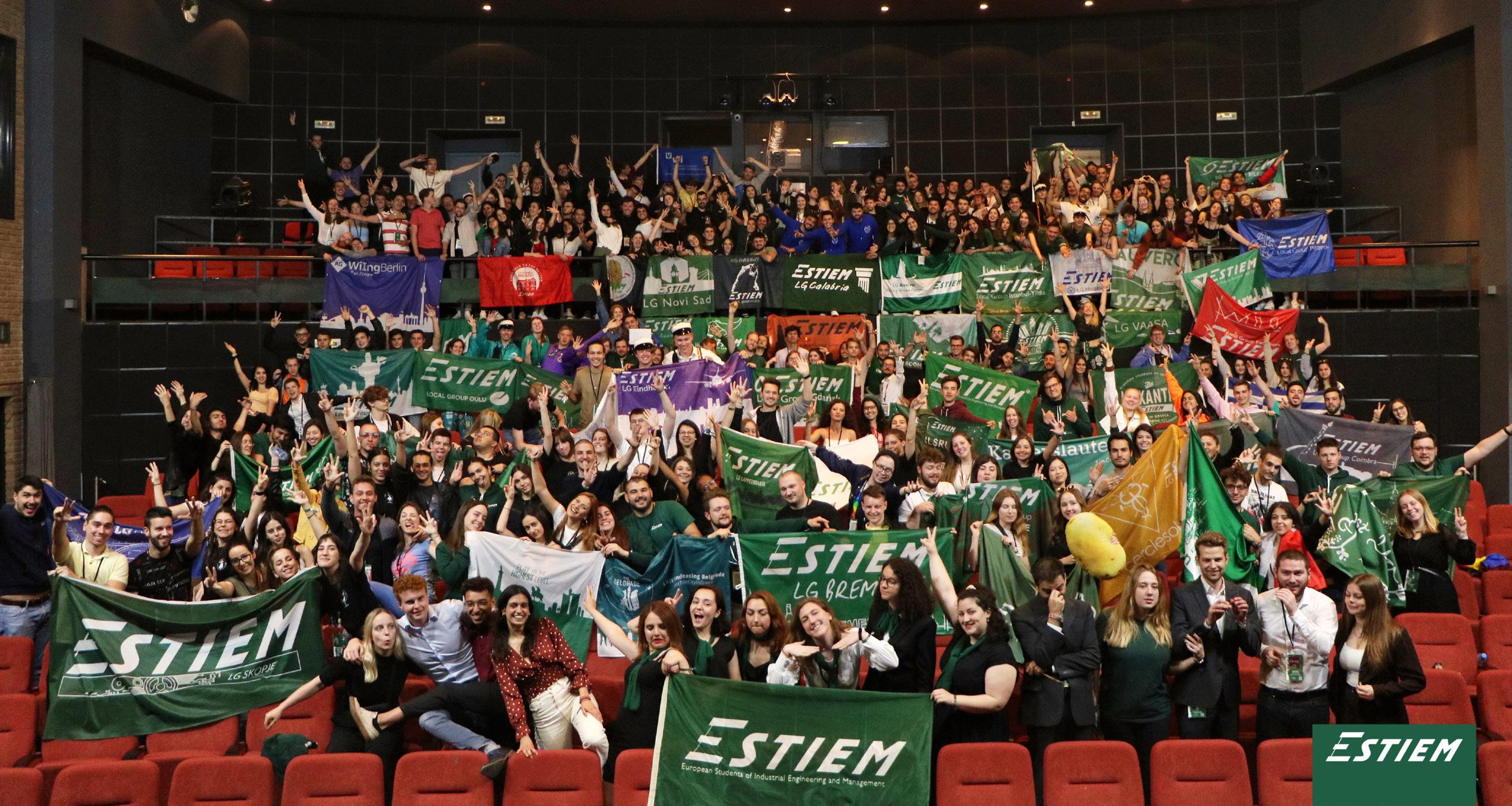


F: I would like students to be more active in Academic and Career events, both in the international and local levels, and in raising their opinions when it comes to Education, by proactively talking with local professors.
J: What is your best memory from an ESTIEM event?
F: This is a very hard question to answer - I’ve attended a lot of events so far and had the chance to experience a lot of great moments. One of the best moments I can remember was singing in the bus during CM Famagusta. It was a moment full of ESTIEM Spirit, and it impressed me especially because it was my first time attending a CM.
INSIDE ESTIEM 32 ESTIEM Magazine | 63rd issue - Exploration and Advancement
Vice President of Education:
Joana Vaz interviews Francisca Trigueiros
Joana Vaz Local Group Lisbon
Francisca Trigueiros
Local Group Porto
D: What do you think will happen to ESTIEM in 10 years? 20 years?
K: That is a very difficult question. Who would have anticipated the current position of ESTIEM 20 years ago? One possibility for the future that I would like to see is ESTIEM to enhance its social impact. Our network has the ability to make a big difference in creating a better future. By assisting students in developing into the leaders of tomorrow who will make better judgments for a global society, I think ESTIEM will have a stronger influence. Next to that, and I hope I don’t think too big; how about a stable IT infrastructure?
D: For you, what is the ‘must-attend’ ESTIEM event?
K: I consider our Lean Six Sigma Green Belt course to be extremely beneficial for every MINT student! Participating in the program improved my problem-solving techniques, teamwork, and structural thinking. Additionally, it was a highly enjoyable but also valuable experience.



D: While you were in ESTIEM, what was the best/worst punishment you received?
K: I am a big fan of the good old refreshing windmill that I had the honour of performing a handful of times.
D: How do you see ESTIEM developing in the next year in terms of alignment with the requirements of EU grants?
K: We are already highly in line with the standards, as evidenced by the outcome of the most recent application for the EU Grant for Civil Society Cooperation in the Field of Youth. In each of the three evaluation fields—Relevance, Quality, and Impact—ESTIEM was able to earn more than 70% of the possible points. I can see ESTIEM advancing in areas like youth participation and constructive dialogue. In addition, I envisage ESTIEM establishing connections and taking use of opportunities offered by EU institutions.
INSIDE ESTIEM ESTIEM Magazine | 63rd issue - Exploration and Advancement 33
President:
Daria Bakaeva interviews Kai Heine
Daria Bakaeva Local Group Moscow
Kai Heine Local Group Berlin
Sturkenboom Local Group Eindhoven
B: Creating and presenting the budget in the Council Meeting can be very stressful. What will help you to stay grounded in case stress tries to take over?
M: To be honest I don’t think that presenting the budget is the stressful part. As long as the budget makes sense and you can argue why you made a specific decision it should be fine. For me, the stressful part of creating the ESTIEM budget is making sure that there is enough income to create a flexible budget in which as less costs as possible are cut. The budget is a tool to support the functioning of the Board, keep the network financially stable, and last but not least develop the network. As VP of Finance I want to develop the network as much as possible, and a high income would help with that. That is why, the most stressful part is arranging a high income, not necessarily presenting the budget.
B: What are the best aspects of ESTIEM that we can sell to companies in your opinion?


M: The people. We have very talented and smart students from all over Europe with high intercultural awareness and a variety of hard and soft skills. Since Industrial Engineering and Management is quite broad there are many industries that we can tackle and a lot of different companies we can focus on. In ESTIEM it has always been about our people. We develop them through our offers and by bringing them in contact with external stakeholders (Companies, Universities, Professors, etcetera). In conclusion, we offer very well-developed (academic, career, intercultural, and personal) people to companies.
B: Can money buy happiness?
M: No, but it can help a lot. As you might have noticed inflation is definitely not helping in making life payable. Especially, when we want to enjoy wonderful and amazing ESTIEM Events or when we want to visit our friends in other countries money may come in handy. So, with money our travels can be supported which can bring us a bit closer to happiness. However, as you might have experienced already, the real happiness comes from being with the people you love, experience new cultures, explore new places, and basically having a lot of fun. That is why ESTIEM is the perfect place to lead you to happiness.
INSIDE ESTIEM 34 ESTIEM Magazine | 63rd issue - Exploration and Advancement
Vice President of Finance:
32nd board interviews Max Sturkenboom
Max
S: If you were to change the ESTIEM color, what would you pick?
P: I actually have never thought about this before, as I truly believe that green is very well suited for ESTIEM. The color itself is considered to be calming, motivating, optimistic and natural. Words that I believe describe our purpose and activity as an organization. I do believe that ESTIEM is a place where students find themselves, where they get motivated and optimistic about their future, but also for the present, giving their best to always become better. A place that just feels like the place to be, that feels natural, like a home. So, even if I had the chance to change our color, I wouldn’t do it. I think that ESTIEM Green is the perfect fit for ESTIEM.

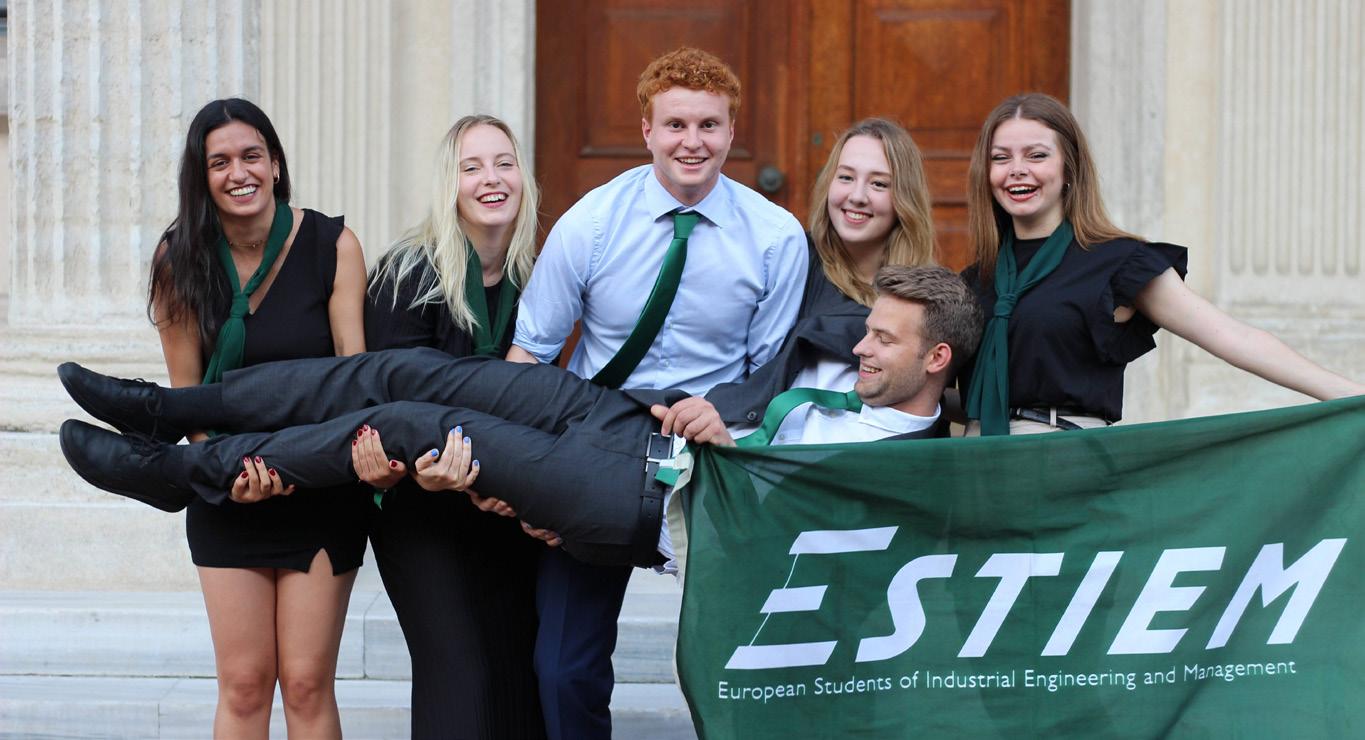
S: Which one is the real name of the position you are holding? Public Relations or Party Relations?

P: I want to believe that it is a mix of both. I would say that Public Relations are essential for the sustainability of an organization and especially of an NGO, as it increases brand credibility. So, even though Public Relations is a necessary element of my work, sometimes you can develop it during parties. Therefore, Party Relations are part of Public Relations, two attributes that I embrace.
S: What is the one piece of advice you would give to a new ESTIEMer who has just joined the network?
P: I would give them the same advice I followed subconsciously myself when I first joined the network. Take advantage of every opportunity that comes your way! This can be from getting involved in the organization of a Local activity or event to getting involved in a European team of the network. The benefits of each experience are countless and you will look back at yourself only being thankful for your decisions as they will transform you into a different person. If you are afraid of travelling alone for the first time, just do it! You will learn so much from the experience itself, but you will also become more extroverted. The latter I share through my personal experience, as I travelled alone in my very first event, not even thinking about how introverted and shy I was at the moment. In the end, the people I met during the event couldn’t believe me when I told them that I was usually very shy and didn’t talk much. So, don’t be afraid to get out of your comfort zone and aim high!
INSIDE ESTIEM ESTIEM Magazine | 63rd issue - Exploration and Advancement 35
Vice President of Public Relations:
Sena Horoz interviews Petra Maria Kantartzi
Sena Horoz Local Group Istanbul-Yildiz
Petra Maria Kantartzi Local Group Xanthi
Sena Horoz Local Group Istanbul-Yildiz
ESTIEM PODCAST

An overview of the ESTIEM Podcast’s establishment over 2021 and 2022
The Beginning
The idea of having a podcast for ESTIEM was around for quite some time already, and the first attempts have been made the previous year by recording some episodes with ESTIEM’s departments. However, due to a misfortunate accident, the recordings got lost because the responsible ESTIEMer’s, Viktoria Heyen, laptop got stolen.
With that and having had the idea on the table, I felt intrigued to take on the challenge and initiate the idea once again, from scratch.
Defining the aim
The idea I had for the podcast from the beginning was, to provide value to listeners but make it fun. Therefore my idea turned out ESTIEM podcast to be “a tool to reach ESTIEMers and beyond, with insightful content about ESTIEM and IEM related topics”, a platform where we gather different people each time while shedding light on a specific topic. It should not only focus on ESTIEM solely (why we went with 6 episodes about ESTIEM on the first season will be explained in the content creation section), or only on professional oriented content that possibly could be boring. So the mission statement of ESTIEM Podcast evolved to this:
“ESTIEM Podcast aims to deliver entertaining and insightful content, to connect ESTIEMers and IEM Europe by sharing experience and knowledge on IEM topics and ESTIEM. “
Gathering
After having an aim and some ideas in mind, it was time to gather a team and start the work. We began with four members: Vasco Rodrigues from Aveiro, Erik Viktor Pymay Jasinski from Gothenburg, Umut Kizilates from Ankara-Bilkent, and myself, Sena Horoz. The initial plan was to have three main positions: “Content creator” to be responsible primarily for the content and scripts, “Narrator” to facilitate and record the episodes, and “Sound editor” to be responsible for technical aspects such as editing.
We went with a more project(episode)-based approach after getting into the work, with the dynamics within the team and motivation of team members, rather than sticking to only one part/ task of it.
Since we were the pioneers and were learning everything on the way, we kept the flexibility and let everyone be involved in each part of the project. On one side, it was really nice to have collaborative work all the time, but on the other hand, it was hard to keep track of the tasks, and not everyone felt a sense of responsibility from time to time for some of the tasks. Therefore, I believe that having more strict boundaries between positions and having sub-teams inside the team would lead to more efficiency and would ease the leader’s workload.
Content Creation - 1st Season
While recruiting members, I also collected input on elium, and checked the previous year’s work and ideas:
INSIDE ESTIEM 36 ESTIEM Magazine | 63rd issue - Exploration and Advancement
a team & team structure
The main aspects we considered were that the Podcast is insightful but enjoyable to listen to, as it is a tool that people use in their daily lives. While brainstorming possible topics, we made an important decision: the podcast (episodes) will last forever, so we should make the episodes in a logical order. That is, we cannot (or should not) jump right into deep topics without first demonstrating what ESTIEM is all about and what our organization’s core values are. With that in mind, we’ve decided to start with a season that explains what ESTIEM is. The plan was always to start small, introduce everyone to the network, and then progress to the deeper side of “IEM-World.”
One of our initial concerns was the target audience. “How will we get experienced/alumni ESTIEMers to listen to the ESTIEM Podcast if we introduce the network during the first season?” To avoid this problem, we kept the topics covered in the episodes as broad as possible so that everyone, not just newcomers, could relate. In addition, we’ve tried to bring different perspectives with a variety of guest speakers (one ESTIEM alumnus, one experienced, and one new ESTIEMer) in each episode. We had 18 guests in total, three per episode, from 14 different local groups. With that being said, the first season covered the following 6 episodes: 1. First ESTIEM Events 2. Friendships in ESTIEM 3. International Nights 4. Working in an international environment 5. Council Meeting 6. Foundation of ESTIEM
Production Process
It all started with the season’s conceptualization, which came after having the focus topic, or as we call it, the “season.” Then came the brainstorming and putting the ideas together in a logical order, and building the episodes on top of each other. Despite the fact that the topics were decided from the start, the episodes were created in cycles of record-edit-publish, rather than recording everything at once and then slowly publishing it.
We chose smaller cycles for two reasons: first, we wanted to be able to improve each time, and second, we didn’t want to make the same mistake in all of the episodes.
We had a very tight schedule and had to set strict deadlines because our goal was to finish the first season before the Council Meeting and our first episode was published in March. As we maintained episode-based cycles, we realized that the deadlines we set from the start were unrealistic and too tight. We were unable to stick to the timeline for a variety of reasons, including team member availability, last-minute cancellations/ changes in the guests, and so on. As a result, we dropped one episode from our original first season plan (the “life after ESTIEM” episode) and moved the “foundation of ESTIEM” episode to after CM Belgrade.
As previously stated, our vision for the ESTIEM Podcast was always to take baby steps, introducing the network and then going deeper into IEM Europe. However, before doing so, it is critical to assess the processes and structures of the ESTIEM Podcast in order to proceed with improved and stronger steps.
As there is currently no leader for the entity, my successor, Vice President of Public Relations of the 33rd Board, Petra, will take over and lead the entity until the 33rd Board decides how to proceed with the entity.
The Future Reflection
Starting from scratch is never easy, but it is always a rewarding and fun journey. Once again, it was incredible to have the opportunity to be in this “playground,” and the mistakes we made along the way turned out to be learning points not only for the podcast but also for our personal growth, I must say. I am very happy and proud to be a part of the ESTIEM Podcast, and I would like to thank every guest and listener for their contributions to this incredible project.
INSIDE ESTIEM ESTIEM Magazine | 63rd issue - Exploration and Advancement 37
More importantly, I’d like to thank my team, Erik Viktor Pymay Jasinski, Vasco Rodrigues, Umut Kizilates, Deeqo Farah and Sude Cetinkaya, for all of their hard work in making the ESTIEM podcast a reality.
Looking forward to listening to more episodes in the future!
In High ESTIEM, Sena Horoz Vice President of Public Relations of the 32nd
Listen to ESTIEM Podcast here!
Become a corporate developer who is not afraid to tackle challenging problems
At LUT-University you can study Industrial Engineering and Management both in Bachelor program and in two Master’s programs
Build bridges between technology and business
Bachelor's Programme in Industrial Engineering and Management
https://www.lut.fi/web/en/admissions/bachelors studies/industrial engineering and management
Understand the impact of global megatrends on innovation management in firms
Master's Programme in Global Management of Innovation and Technology
https://www.lut.fi/web/en/admissions/masters studies/msc in technology/industrial engineering and management/global management of innovation and technology
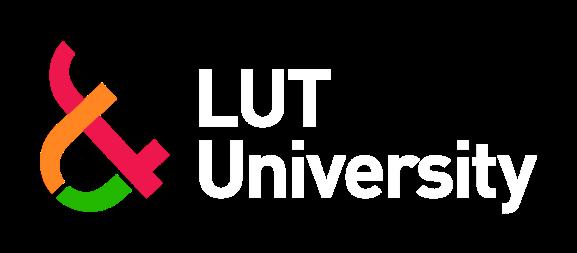
Become a top expert in international logistics and innovation
Master's Programme in Innovation and Logistics
https://www.lut.fi/web/en/admissions/masters studies/msc in technology/industrial engineering and management/innovation and logistics
Curious people change the world be one of us.
Our programs are located in Lappeenranta, Lahti and Kouvola, Finland

INSIDE ESTIEM 38 ESTIEM Magazine | 63rd issue - Exploration and Advancement
INDUSTRIAL ENGINEERING AND MANAGEMENT
Bachelor’s Programme in Industrial Engineering and Management
Master’s Programme in Global Management of Innovation and Technology
Master’s Programme in Innovation and Logistics
HOW TO WRITE FOR ESTIEM MAGAZINE
If you are interested in writing an article for ESTIEM Magazine, it is as easy as scanning the QR code bellow and filling out the form. It lets us know that you are interested so we will contact you and guide you through the whole process.
Article Suggestion Form
You can suggest an article, another author (ESTIEMer or not), or yourself to be an author - we are always looking for more ideas! It doesn’t have to be related to the focus topic.
If you feel like you are unsure what being an author entails, you can check out our Author Guidelines by scanning the QR code bellow.
Author Guidelines
INSIDE ESTIEM ESTIEM Magazine | 63rd issue - Exploration and Advancement 39
CHALMERSUNIVERSITYOFTECHNOLOGY
DEPARTMENTOFTECHNOLOGYMANAGEMENTANDECONOMICS
Doyouwanttostudyinacreativeandinnovativeenvironmentwhere academy,publicorganisations,industry,andentrepreneurscometogether?
OurfourMaster’sprogrammeswithinTechnologyManagementandEconomics aretaughtinEnglishandofferacombinationofsolidtheoreticframeworks, appliedprojectsandstrongconnectiontobusinessandindustry.Thiscombination ensuresarapidlearningcurveandexcitingjobopportunitiesaftergraduation.
□EntrepreneurshipandBusinessDesign,MSc,120credits


□ManagementandEconomicsofInnovation,MSc,120credits

□QualityandOperationsManagement,MSc,120credits



□SupplyChainManagement,MSc,120credits
WhenyoustudyatChalmers,youlearntothinkindependently,andtouse engineeringmethodstotacklefuturechallenges.Weencourageyourcreativity, andbelieveintheimportanceoffreethinking,lettingyoutestyourownideasfor real.WearelocatedinGothenburg,Swedenandareconsistentlyrankedamong thetop100EngineeringUniversitiesintheworld.
Applicationopensinmid-Octobereveryyear.
chalmers.se/masters

EU/EEACitizensarenotrequiredtopaytuitionfees.
“Ithasbeenanexcitingjourney, especiallythefactthatstudying atChalmersbroughtmeandmy friends(whonowbecamemy businesspartners)acrossthe globetoexperiencethereal worldofbeinganinternational entrepreneur.” -RichZapata Rosas,Entrepreneurshipand BusinessDesignstudentat Chalmers
Master’sstudies atChalmers
ChalmersProgramme days2022
















































































